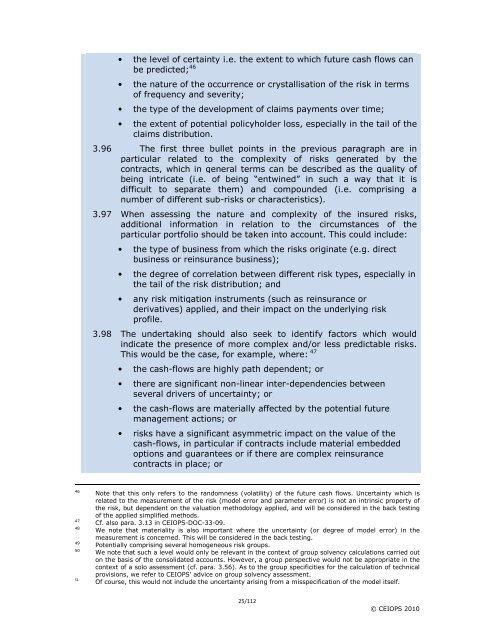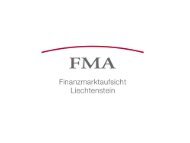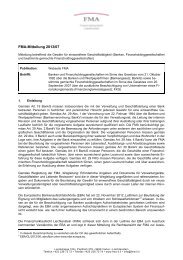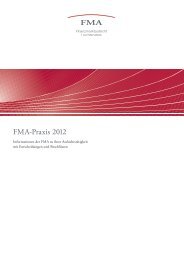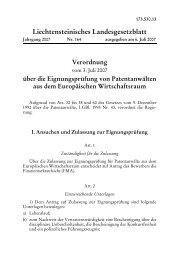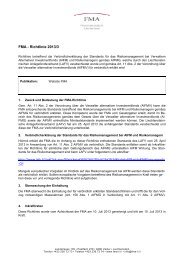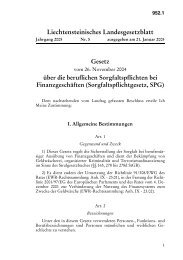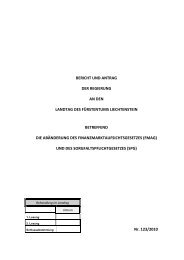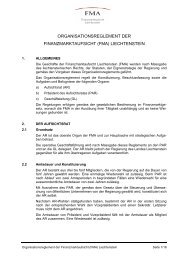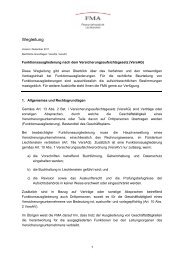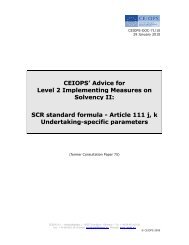CEIOPS' Advice for Level 2 Implementing ... - EIOPA - Europa
CEIOPS' Advice for Level 2 Implementing ... - EIOPA - Europa
CEIOPS' Advice for Level 2 Implementing ... - EIOPA - Europa
You also want an ePaper? Increase the reach of your titles
YUMPU automatically turns print PDFs into web optimized ePapers that Google loves.
• the level of certainty i.e. the extent to which future cash flows can<br />
be predicted; 46<br />
• the nature of the occurrence or crystallisation of the risk in terms<br />
of frequency and severity;<br />
• the type of the development of claims payments over time;<br />
• the extent of potential policyholder loss, especially in the tail of the<br />
claims distribution.<br />
3.96 The first three bullet points in the previous paragraph are in<br />
particular related to the complexity of risks generated by the<br />
contracts, which in general terms can be described as the quality of<br />
being intricate (i.e. of being “entwined” in such a way that it is<br />
difficult to separate them) and compounded (i.e. comprising a<br />
number of different sub-risks or characteristics).<br />
3.97 When assessing the nature and complexity of the insured risks,<br />
additional in<strong>for</strong>mation in relation to the circumstances of the<br />
particular portfolio should be taken into account. This could include:<br />
• the type of business from which the risks originate (e.g. direct<br />
business or reinsurance business);<br />
• the degree of correlation between different risk types, especially in<br />
the tail of the risk distribution; and<br />
• any risk mitigation instruments (such as reinsurance or<br />
derivatives) applied, and their impact on the underlying risk<br />
profile.<br />
3.98 The undertaking should also seek to identify factors which would<br />
indicate the presence of more complex and/or less predictable risks.<br />
This would be the case, <strong>for</strong> example, where: 47<br />
• the cash-flows are highly path dependent; or<br />
• there are significant non-linear inter-dependencies between<br />
several drivers of uncertainty; or<br />
• the cash-flows are materially affected by the potential future<br />
management actions; or<br />
• risks have a significant asymmetric impact on the value of the<br />
cash-flows, in particular if contracts include material embedded<br />
options and guarantees or if there are complex reinsurance<br />
contracts in place; or<br />
46<br />
Note that this only refers to the randomness (volatility) of the future cash flows. Uncertainty which is<br />
related to the measurement of the risk (model error and parameter error) is not an intrinsic property of<br />
the risk, but dependent on the valuation methodology applied, and will be considered in the back testing<br />
of the applied simplified methods.<br />
47<br />
Cf. also para. 3.13 in CEIOPS-DOC-33-09.<br />
48 We note that materiality is also important where the uncertainty (or degree of model error) in the<br />
measurement is concerned. This will be considered in the back testing.<br />
49 Potentially comprising several homogeneous risk groups.<br />
50 We note that such a level would only be relevant in the context of group solvency calculations carried out<br />
on the basis of the consolidated accounts. However, a group perspective would not be appropriate in the<br />
context of a solo assessment (cf. para. 3.56). As to the group specificities <strong>for</strong> the calculation of technical<br />
provisions, we refer to CEIOPS’ advice on group solvency assessment.<br />
51 Of course, this would not include the uncertainty arising from a misspecification of the model itself.<br />
25/112<br />
© CEIOPS 2010


